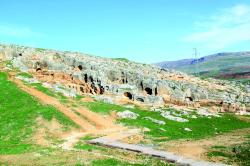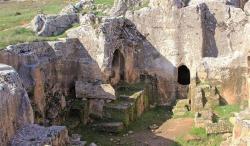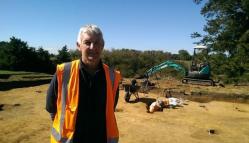INSTITUT SUPERIEUR D'ANTHROPOLOGIE
INSTITUTE OF ANTHROPOLOGY
ONLINE COURSES / COURS A DISTANCE
SPRING TERM : APRIL 2015
REGISTER NOW
TURQUIE – 
 Perge - Excavation activities at the archaeological site in the ancient city of Perge, which was one of the centers of the Kommagene civilization, will soon commence with the aim of opening up the site for tourism. Excavations will begin soon in the ancient city, located in the southeastern province of Adıyaman, five kilometers away from the city center. It is home to some 200 stone tombs as well as a still-functional fountain. The ancient city, located between the capital of the Kommagene Kingdom, Samosata (today Samsat), and Melitene (today Malatya), is mentioned in Roman resources for its beautiful water. The city served as a resting place for travelers, caravans and armies. The archaeological site directly beside the ancient city is waiting to be discovered. Governor Mahmut Demirtaş said the ancient city of Perge held significance for the country’s tourism. He said the Provincial Special Administration carried out excavations in the region 13 years ago, and the outcome was the discovery of 363 historical and cultural artifacts as well as the stone tombs. Demirtaş said the excavation work had to be suspended because of natural hazards.
Perge - Excavation activities at the archaeological site in the ancient city of Perge, which was one of the centers of the Kommagene civilization, will soon commence with the aim of opening up the site for tourism. Excavations will begin soon in the ancient city, located in the southeastern province of Adıyaman, five kilometers away from the city center. It is home to some 200 stone tombs as well as a still-functional fountain. The ancient city, located between the capital of the Kommagene Kingdom, Samosata (today Samsat), and Melitene (today Malatya), is mentioned in Roman resources for its beautiful water. The city served as a resting place for travelers, caravans and armies. The archaeological site directly beside the ancient city is waiting to be discovered. Governor Mahmut Demirtaş said the ancient city of Perge held significance for the country’s tourism. He said the Provincial Special Administration carried out excavations in the region 13 years ago, and the outcome was the discovery of 363 historical and cultural artifacts as well as the stone tombs. Demirtaş said the excavation work had to be suspended because of natural hazards.
http://www.hurriyetdailynews.com/traces-of-ancient-civilization-to-be-searched-in-adiyaman.aspx?pageID=238&nID=79905&NewsCatID=375
BELIZE –  Cayo - A British newspaper is sensationalizing an archeological discovery in Belize. The Daily Mail online calls it “evidence of child trafficking in the Mayan Midnight Terror Cave in Cayo.” The article refers to a 3 year study of the cave by Belizean researchers and Archaeologists from California State University which ended in 2010. The article speaks of human remains of adults and children between the ages of 6 and 14 along with the remnants of sacrificial altars dating back to between 700 and 900 AD. And then it says, foreign scientists and researchers believe that the “underworld network of caves in Belize may have been used to traffic Mayan children as young as six for sacrifice.” We contacted the Director of the Institute of Archaeology Dr. John Morris and he confirms that the cave was used for ritual sacrifices but adds that “ to take the data and speak of "children trafficking " is misleading at best and warrants more in depth research. The fact that this has not been published in a peer review journal suggests that the ideas presented are speculative”.
Cayo - A British newspaper is sensationalizing an archeological discovery in Belize. The Daily Mail online calls it “evidence of child trafficking in the Mayan Midnight Terror Cave in Cayo.” The article refers to a 3 year study of the cave by Belizean researchers and Archaeologists from California State University which ended in 2010. The article speaks of human remains of adults and children between the ages of 6 and 14 along with the remnants of sacrificial altars dating back to between 700 and 900 AD. And then it says, foreign scientists and researchers believe that the “underworld network of caves in Belize may have been used to traffic Mayan children as young as six for sacrifice.” We contacted the Director of the Institute of Archaeology Dr. John Morris and he confirms that the cave was used for ritual sacrifices but adds that “ to take the data and speak of "children trafficking " is misleading at best and warrants more in depth research. The fact that this has not been published in a peer review journal suggests that the ideas presented are speculative”.
http://www.7newsbelize.com/sstory.php?nid=31925
ROYAUME UNI –  Wisbech - Archaeologists hope they are close to solving a centuries old mystery. Members of Fenland Archaeology Society (Fenarch) are investigating a moated site in West Drove, Wisbech. But it is unclear what the site was used for after digs have brought up rubble and rare games but no foundations of a homestead.Members are hoping that the answer may lie in geophysical surveys which are being conducted on the site over the next week. Treasurer Chris Green says one theory is that wooden homes were built on the site. She said: “Hopefully the geophys will solve the mystery. It is something we may never get to the bottom of but hopefully it will take us further and explain why we have brick work there but no foundations for a substantial building. “Every time we dig, we get brick coming up but we can’t figure it out.” The moat may have been used to keep animals within the site or bring water for brick building. There is also evidence of a drove. While the site has not given up all of its secrets, the four digs have yielded some results with animal bones, which show the residents were eating well. Pottery and metal items have been found, along with a rare game called Nine Men’s Morris. The society has also uncovered a Roman settlement in Wisbech St Mary after a farmer had begun to dig up pottery. A recent dig has uncovered coins, pin brooches and other items. Mrs Green said: “Roman activity in the Fens is not really known as a lot of the area would have been under water. If they had not been farming sometimes they were making salt. “We are still working through the report.”
Wisbech - Archaeologists hope they are close to solving a centuries old mystery. Members of Fenland Archaeology Society (Fenarch) are investigating a moated site in West Drove, Wisbech. But it is unclear what the site was used for after digs have brought up rubble and rare games but no foundations of a homestead.Members are hoping that the answer may lie in geophysical surveys which are being conducted on the site over the next week. Treasurer Chris Green says one theory is that wooden homes were built on the site. She said: “Hopefully the geophys will solve the mystery. It is something we may never get to the bottom of but hopefully it will take us further and explain why we have brick work there but no foundations for a substantial building. “Every time we dig, we get brick coming up but we can’t figure it out.” The moat may have been used to keep animals within the site or bring water for brick building. There is also evidence of a drove. While the site has not given up all of its secrets, the four digs have yielded some results with animal bones, which show the residents were eating well. Pottery and metal items have been found, along with a rare game called Nine Men’s Morris. The society has also uncovered a Roman settlement in Wisbech St Mary after a farmer had begun to dig up pottery. A recent dig has uncovered coins, pin brooches and other items. Mrs Green said: “Roman activity in the Fens is not really known as a lot of the area would have been under water. If they had not been farming sometimes they were making salt. “We are still working through the report.”
http://www.fenlandcitizen.co.uk/news/latest-news/fenland-archaeologists-hope-to-solve-mystery-behind-wisbech-moat-1-6638665
ITALIE –  Pompei - Dr Zena Kamash from the Department of Classics at Royal Holloway, University of London, has discovered the photos tourists take of Pompeii are almost identical to those taken by our ancestors. After examining 19th and early 20th century lantern slides of Pompeii and modern day photos from review site TripAdvisor, Dr Kamash discovered the shots taken around the site are remarkably similar.
Pompei - Dr Zena Kamash from the Department of Classics at Royal Holloway, University of London, has discovered the photos tourists take of Pompeii are almost identical to those taken by our ancestors. After examining 19th and early 20th century lantern slides of Pompeii and modern day photos from review site TripAdvisor, Dr Kamash discovered the shots taken around the site are remarkably similar.
http://www.alphagalileo.org/ViewItem.aspx?ItemId=150892&CultureCode=en
CANADA –  Nain - The oldest snowmobile in Labrador is one step closer to getting back in running order after nearly a century of it being abandoned in Nain. Two years ago a team of archeologists in Nunatsiavut uncovered the Ford Model T that was converted to ride through snow on skis and tracks. The team has been in the process of restoring antique vehicle ever since. "The engine and transmission are being torn down and are in the process of being rebuilt, so body work has been started," said Jamie Brake, Nunatsiavut archeologist. "Progress has been great so far." In 1927, the snowmobile was brought to Nain for a scientific exhibition, and after 15 months on display was abandoned.
Nain - The oldest snowmobile in Labrador is one step closer to getting back in running order after nearly a century of it being abandoned in Nain. Two years ago a team of archeologists in Nunatsiavut uncovered the Ford Model T that was converted to ride through snow on skis and tracks. The team has been in the process of restoring antique vehicle ever since. "The engine and transmission are being torn down and are in the process of being rebuilt, so body work has been started," said Jamie Brake, Nunatsiavut archeologist. "Progress has been great so far." In 1927, the snowmobile was brought to Nain for a scientific exhibition, and after 15 months on display was abandoned.
http://www.cbc.ca/news/canada/newfoundland-labrador/rebuild-of-labrador-s-first-snowmobile-well-underway-1.3002724
BULGARIE – Shipka- Bulgaria's Culture Minister Vezhdi Rashidov ordered an urgent inspection in the tomb of the Thracian King Seuthes III after a collapse had been reported by the municipality of Kazanlak. According to local Press TV, the Golyamata Kosmatka Mound, which contains the tomb, collapsed with nearly a meter and 5 cubic metres of soil had been removed from its corridor. There is danger of the metal facilities, which sustain the corridor of the tomb leading to the chambers, to collapse, daily Dnevnik reports. The Culture Ministry informs that the tomb remains closed at the moment due to the presence of leaks and the collapse of soil. The tomb of Thracian King Seuthes III, which is located 1 kilometre south of the town of Shipka, was discovered in 2004 by the late archaeologist Georgi Kitov. -
http://www.novinite.com/articles/167350/Bulgaria%27s+Culture+Ministry+Inspects+Collapse+in+Thracian+Tomb?
NOUVELLE ZELANDE –  Waikato - Archaeologists in Waikato suspect they've found the South Pacific's biggest pre-European gardening operation, which spans about 130 kilometres along the Waikato River.For the past two weeks they have been excavating a two hectare site near Mount Taupiri where a new stretch of road will go. The latest dig has uncovered kumara and storage pits which are thought to have been from about the late 15th century. An archaeologist hired by the New Zealand Transport Agency, Warren Gumbley, said their latest discovery was part of a bigger tribal operation, which stretches from Arapuni to Mercer. "When you encounter it, the sites you can identify because of the large borrow pits that have been used for the quarrying," he said. "These can be maybe 30 metres across and up to five metres deep. Obviously the soil itself, which is very highly modified with a lot of sand and gravel in it ... It is definitely an adaptation that allows Polynesian horticulture to be adapted to New Zealand."
Waikato - Archaeologists in Waikato suspect they've found the South Pacific's biggest pre-European gardening operation, which spans about 130 kilometres along the Waikato River.For the past two weeks they have been excavating a two hectare site near Mount Taupiri where a new stretch of road will go. The latest dig has uncovered kumara and storage pits which are thought to have been from about the late 15th century. An archaeologist hired by the New Zealand Transport Agency, Warren Gumbley, said their latest discovery was part of a bigger tribal operation, which stretches from Arapuni to Mercer. "When you encounter it, the sites you can identify because of the large borrow pits that have been used for the quarrying," he said. "These can be maybe 30 metres across and up to five metres deep. Obviously the soil itself, which is very highly modified with a lot of sand and gravel in it ... It is definitely an adaptation that allows Polynesian horticulture to be adapted to New Zealand."
http://www.radionz.co.nz/news/te-manu-korihi/269218/pre-european-garden-discovery-in-waikato?
ANTHROPOLOGIE –  - A psychology study from The University of Texas at Austin sheds new light on today's standards of beauty, attributing modern men's preferences for women with a curvy backside to prehistoric influences. The study, published online in Evolution and Human Behavior, investigated men's mate preference for women with a "theoretically optimal angle of lumbar curvature," a 45.5 degree curve from back to buttocks allowing ancestral women to better support, provide for, and carry out multiple pregnancies.
- A psychology study from The University of Texas at Austin sheds new light on today's standards of beauty, attributing modern men's preferences for women with a curvy backside to prehistoric influences. The study, published online in Evolution and Human Behavior, investigated men's mate preference for women with a "theoretically optimal angle of lumbar curvature," a 45.5 degree curve from back to buttocks allowing ancestral women to better support, provide for, and carry out multiple pregnancies.
http://phys.org/news/2015-03-men-body-evolutionary-roots.html